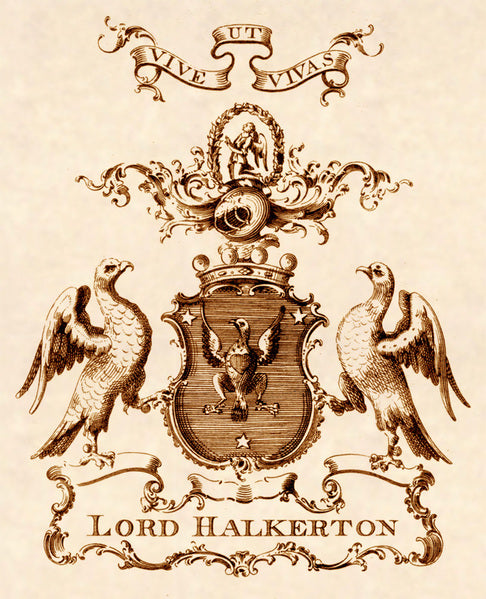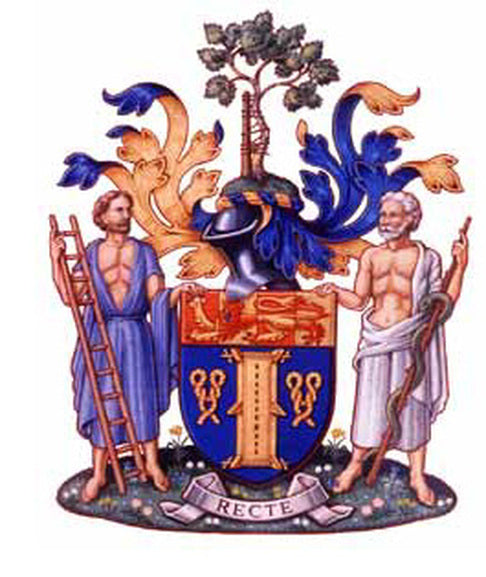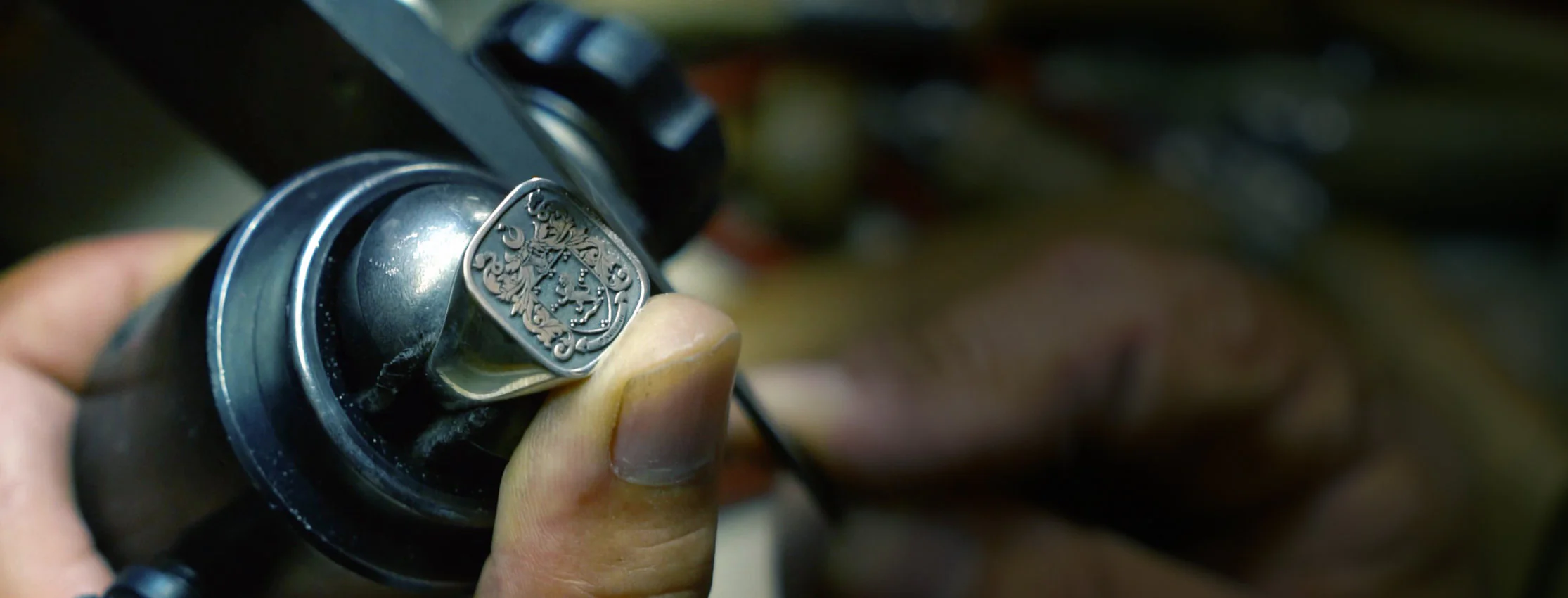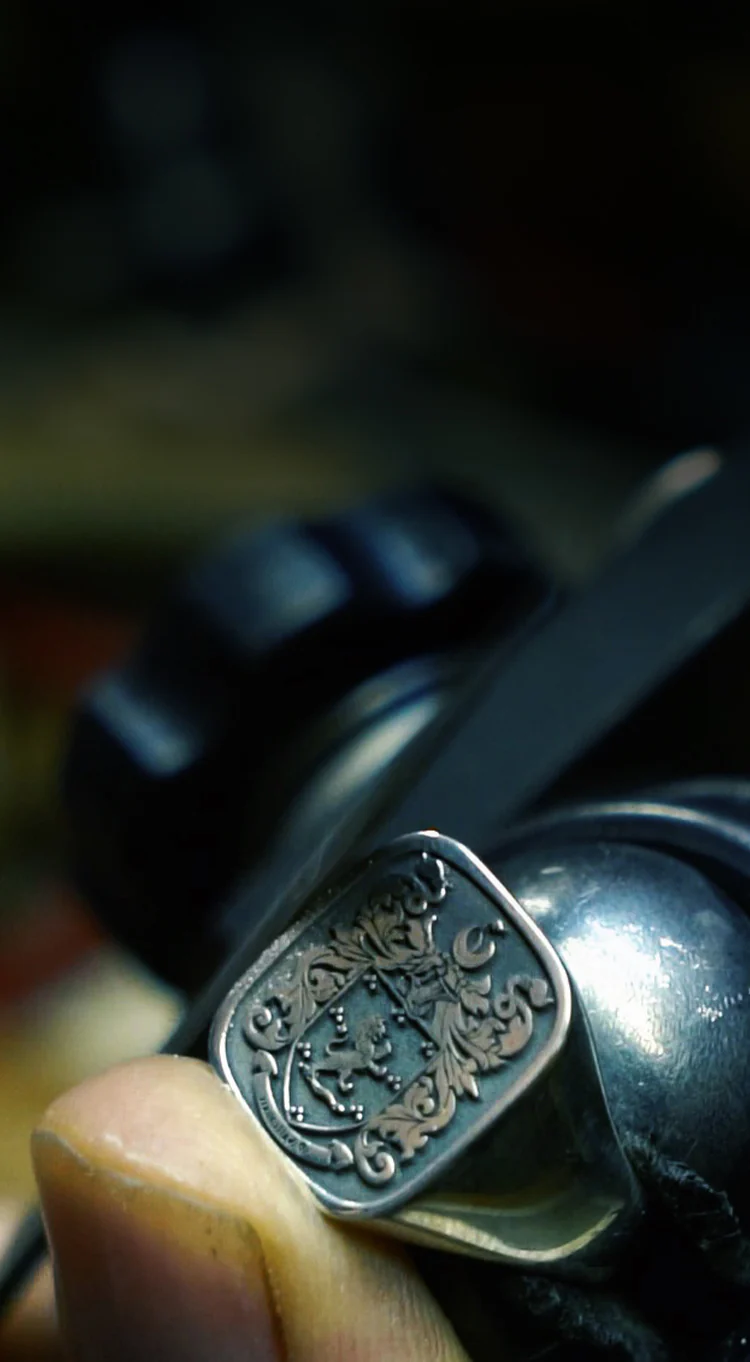

The composition of the Coat of Arms

The shield is the central and essential component of the Coat of Arms. Without the shield there cannot be a coat of arms. The shape of the shield may vary just as the design of the arms as a whole may vary and in fact does. It would be possible to have half a dozen examples of the same coat of arms yet to the uninitiated it would appear that they are different coats. The reason for this is that the artists in creating the arms from the original written description have been influenced as all artists are by varying fashions and styles in Heraldry. The shield can be represented in many ways and directions according to the fashion of the time, what goes on the shield however does not change.
From the shield we come to the helmet. This object exemplifies the essential practical side of original Heraldry. In the days when knights were bold and adventurous everyone wore a helmet of some sort in battle, so everyone was entitled to a helmet in their grant of arms. Heraldry has shown a power of adaption which has enabled it to survive when contemporary arts such as Armor making died out. The shape of the helmet, like that of the shield, is varied and numerous. Some helmets are of the tilting variety, others are the barrel type where the weight began to be borne by the shoulders. More important than the shape of the helmet is its position. In Heraldry’s earliest days the position of the helmet in the coat of arms varied as much as the shape of the helmets, but since the 17th Century there have been rules laid down and generally observed for the delineation of helmets. A royal helmet is of gold, placed affrontée, i.e. with the helmet full face on, and the bars of the helmet down but the visor raised. The helmet of a peer is silver, in profile, visor raised and the bars are of gold. The helmet of a baronet or knight is steel, affrontée, visor up and without bars or grills. The helmet of an esquire or gentleman is steel, in profile with visor closed.

 The wreath is the means of fastening the crest to the helmet. The crest is placed above the helmet. When an artist depicts a shield with the crest above it on the wreath but the latter not attached to the helmet, he is guilty of an heraldic no-no. The crest cannot be airborne as though independent of the rest of the coat of arms. The wreath was of silk with a cord twisted round it and the crest was fastened upon it. The modern practice is to show the wreath in the alternate colors of the shield, usually the primary metal and primary color.
The wreath is the means of fastening the crest to the helmet. The crest is placed above the helmet. When an artist depicts a shield with the crest above it on the wreath but the latter not attached to the helmet, he is guilty of an heraldic no-no. The crest cannot be airborne as though independent of the rest of the coat of arms. The wreath was of silk with a cord twisted round it and the crest was fastened upon it. The modern practice is to show the wreath in the alternate colors of the shield, usually the primary metal and primary color.
The crest itself is perhaps the most well known of all the parts of a coat of arms. Crests were very rudimentary things at one time, probably made of leather or light wood. The wonderful crests of modern times would have been out of place in medieval warfare. One Burmese knight has a Chinese pagoda as his crest. In other cases there are sailing ships in full sail as crests and all sorts of strange and unusual bearings. The origin of the crest is not easy to determine, but there is something to be said for the idea that it came from the sport of the jousting tournament. Tournament jousting was an expensive business and only the wealthier families could afford to partake. The loser had to give up his armor and horse to the victor. In one case, that of Prince Edward, later King Edward I, he was only able to participate in a tournament after his mother pawned some of her Jewelry including crest pendants, to pay for his equipment. In Germany there was a ceremony known as the Helm Schau ( Crest Show) when the squires of the knights participating in the tournament carried their masters helmets on display so that all could see the crests.
In the 16th and 17th Centuries it became the fashion in Britain for the heralds in their Visitations (recording of arms) to grant crests to families which bore arms but which previously had no such addition to the arms. Prior to this time crests were limited to those wealthier families that took part in Knights Tournaments. In many cases arms are allowed in one Visitation and the crest in another some 50 years later. Most probably the crest had been assumed by the family in the meantime, following the well-known principle of keeping up with the Jones’s. There are very few families today who posses arms without a crest in Britain and most of Europe. A notable exception is the Iberian peninsula and Italy where the majority of grants of arms are recorder without a crest in Spain, Portugal and Italy. In Britain the adoption of the crest illustrates the spread of Heraldry among classes such as the richer merchants of the Tudor period, as among the upper middle classes in the late 18th century and 19th century, of ideas which had formerly been the exclusive concern of the landed gentry or knightly families. As to the form of the crests themselves, the original crests when used in battle were obviously very light. In the tournament the crest was often made of leather and could become heavy, but as it was worn only for a short period in the day it’s weight was not a large factor. In battle when the wearer spent the whole day in heavy armor the crest was lighter and made of a thin plate of metal.. In fact the crest may have developed from a comb-like arrangement on the back of the helmet. This appears in many examples in Germany. In manuscript scenes from the early middle ages, plumes are often portrayed on top of the helmet, a custom known in many ages, but not a crest, simply decoration. Thus in real warfare the crest tended to be simple, for example a dragon for the Earl of Lancaster and a lion for the Earl of Nottingham.

The next item in the composition of the Coat of Arms is the lambrequin or mantling at the sides of the shield. This is the flowing drapery arrangement which can be seen in most drawings of Coats of Arms, issuing from the helmet and flowing around the whole arms. The origin of the mantling is again, like many things in Heraldry, very practical. In the burning heat of the Middle East when the Crusades were fought the helmet became very hot and tiring and the mantling began like the old covering for the back of the neck. It was extended to cover a large part of the armor and it was found to be useful not only in protecting from the heat but in catching the sword points of opponents. The colors of the mantling are in general the primary color and primary metal of the shield.
Supporters are perhaps among the most familiar heraldic objects. Supporters are the figures on either side of the coat of arms which hold the shield and appear to support it. They are usually human or animal figures, both real and imaginary, supporters are rarely inanimate objects. It is thought that they originated from the desire of artists and engravers to show the shield actually upheld by something, and to fill in the spaces surrounding the drawing of the coat of arms. In Britain the use of supporters is strictly controlled under the laws of arms and their use is confined to peers, Knights of the Garter, Knights of the Thistle, Knights of St. Patrick, Knights Grand Cross, Knights Grand Commander and certain Knights of the British Empire. In Scotland the use of supporters is much more widespread, not only peers but also private gentleman of ancient lineage any often be entitled to supporters on the grounds of ancient usage.
The final part of the Coat of Arms is the Motto.The Motto is a saying associated with the family that can be part of the coat of arms. Not every coat of arms has a motto, and the rules governing the status of the motto varies from country to country. In England for example the motto is never mentioned or alluded to in the terms of a patent in a grant of arms and mottoes are not hereditary. However in Scotland the motto is included within the terms of the patent and is consequently made the subject of the grant. This makes it an unchangeable part of the coat of arms, and it Scotland, the position of the motto is also specified, usually above the crest. In Ireland the custom is different again, sometimes the motto is expressed in the grant of arms and other times it is not and there is no hard and fast rule. The motto is the subject of much confusion among modern commentators on heraldry. There are countless references to family mottoes in romance and we are usually told that the motto originated at some remote period of the family history, and had a definite allusion to the family fortunes or to family character, or in some way meant a great deal. It is true that some mottoes must have originated in this way, and some even as war cries, like the “Crom a boo”of the Fitzgeralds( Meaning “Crom forever”, Crom being the castle of the Fitzgeralds ). Mottoes are in most cases of late adoption, are quite unsuitable for war cries, and have no more historic allusion than any other respectable matter within a particular family.
Back to menu
Shop Our Products


-
-
Bring Your Idea to Life
Start with a personalized consultation, sharing your vision and preferences with our expert design team. With over 20 years experience we have the knowledge and craftsmanship to create a unique piece of jewelry that will be cherished for generations to come.







